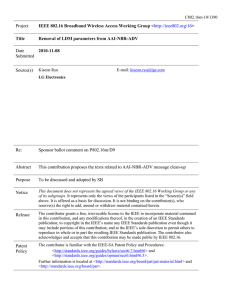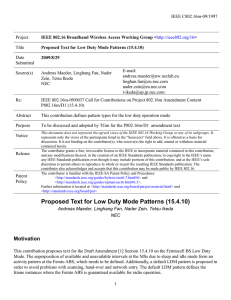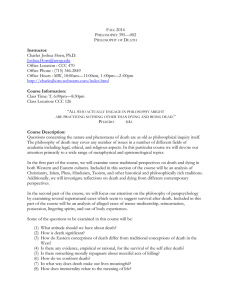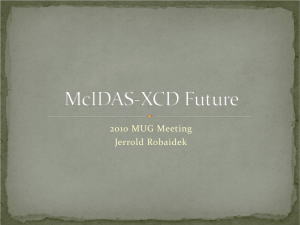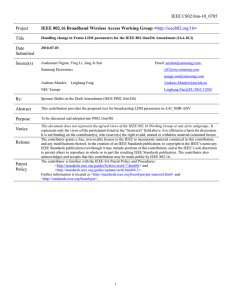IEEE C802.16m-09/1284 Project Title
advertisement
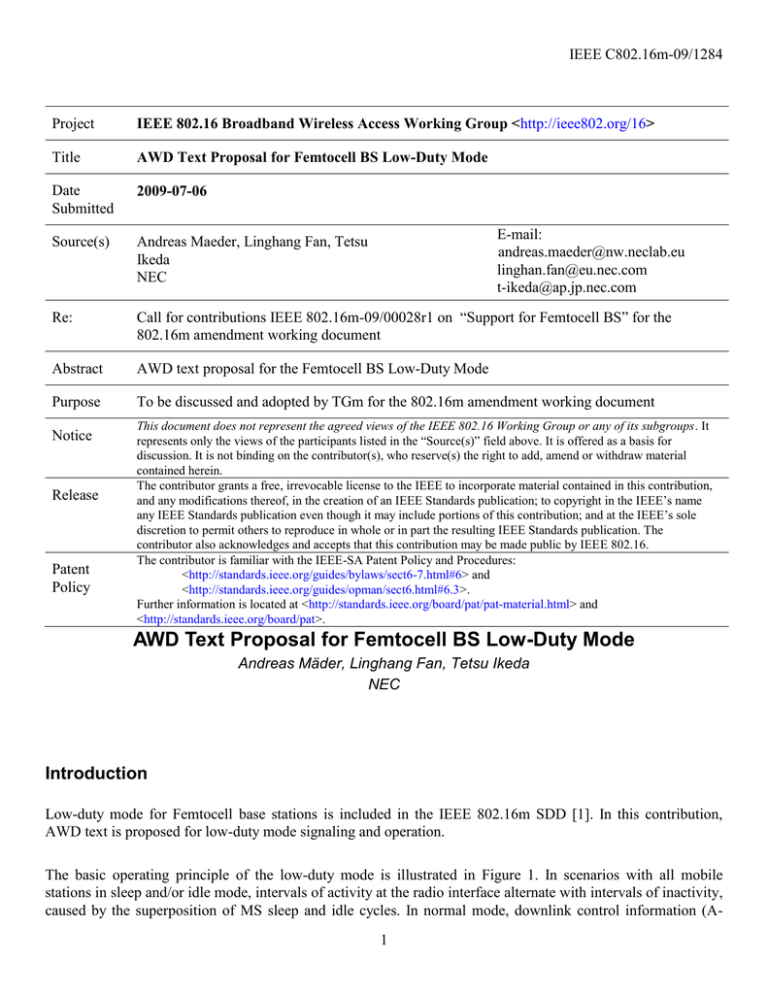
IEEE C802.16m-09/1284
Project
IEEE 802.16 Broadband Wireless Access Working Group <http://ieee802.org/16>
Title
AWD Text Proposal for Femtocell BS Low-Duty Mode
Date
Submitted
2009-07-06
Source(s)
Andreas Maeder, Linghang Fan, Tetsu
Ikeda
NEC
Re:
Call for contributions IEEE 802.16m-09/00028r1 on “Support for Femtocell BS” for the
802.16m amendment working document
Abstract
AWD text proposal for the Femtocell BS Low-Duty Mode
Purpose
To be discussed and adopted by TGm for the 802.16m amendment working document
Notice
Release
Patent
Policy
E-mail:
andreas.maeder@nw.neclab.eu
linghan.fan@eu.nec.com
t-ikeda@ap.jp.nec.com
This document does not represent the agreed views of the IEEE 802.16 Working Group or any of its subgroups. It
represents only the views of the participants listed in the “Source(s)” field above. It is offered as a basis for
discussion. It is not binding on the contributor(s), who reserve(s) the right to add, amend or withdraw material
contained herein.
The contributor grants a free, irrevocable license to the IEEE to incorporate material contained in this contribution,
and any modifications thereof, in the creation of an IEEE Standards publication; to copyright in the IEEE’s name
any IEEE Standards publication even though it may include portions of this contribution; and at the IEEE’s sole
discretion to permit others to reproduce in whole or in part the resulting IEEE Standards publication. The
contributor also acknowledges and accepts that this contribution may be made public by IEEE 802.16.
The contributor is familiar with the IEEE-SA Patent Policy and Procedures:
<http://standards.ieee.org/guides/bylaws/sect6-7.html#6> and
<http://standards.ieee.org/guides/opman/sect6.html#6.3>.
Further information is located at <http://standards.ieee.org/board/pat/pat-material.html> and
<http://standards.ieee.org/board/pat>.
AWD Text Proposal for Femtocell BS Low-Duty Mode
Andreas Mäder, Linghang Fan, Tetsu Ikeda
NEC
Introduction
Low-duty mode for Femtocell base stations is included in the IEEE 802.16m SDD [1]. In this contribution,
AWD text is proposed for low-duty mode signaling and operation.
The basic operating principle of the low-duty mode is illustrated in Figure 1. In scenarios with all mobile
stations in sleep and/or idle mode, intervals of activity at the radio interface alternate with intervals of inactivity,
caused by the superposition of MS sleep and idle cycles. In normal mode, downlink control information (A1
IEEE C802.16m-09/1284
PREAMBLE, SFH) is sent even if no air interface activity is scheduled in a specific frame. In low-duty mode,
transmission of downlink control information is omitted, decreasing interference to adjacent sites and reducing
energy consumption.
sleep cycles
MS
time
available
unavailable
MS
Base
Station
time
resulting low-duty mode pattern
time
Figure 1: Femtocell base station low-duty mode operational principle
Unsolicited Transmissions
Current AWD and SDD text states that MS may wake up at any time from sleep mode, sending an unsolicited
transmission. However, this requires presence of downlink control information for synchronization and
scheduling of uplink transmission opportunities. In low-duty mode, downlink control information is not present
in every frame. To solve this problem, the AMS should try unsolicited transmission only in case if there is
downlink control information present. This requires that the AMS is aware of these frames. Currently, AMS is
only aware of its own sleep cycle, such that the next uplink transmission opportunity corresponds to the next
listening window. However, the Femtocell ABS may be available earlier due to listing windows of other AMS.
Therefore, signaling of the low-duty mode pattern at the ABS reduces delay for unsolicited transmissions.
Figure 2 illustrates this: although the next listening window of AMS 1 is not available yet, it can schedule an
unsolicited transmission due to the listening window of AMS 2.
2
IEEE C802.16m-09/1284
MS 1
time
MS 2
time
Base
Station
time
A
U
A
U
A: availability interval
A
U
A
U: unavailability interval
Figure 2: Unsolicited transmissions in low-duty mode
LDM Pattern Types
Two types of LDM patterns are differentiated: basic and advanced. Basic LDM patterns are defined on
superframe level, while advanced LDM patterns are defined on frame level.
A basic LDM pattern consists of one availability and one unavailability interval measured in superframes. It is
intended for LDM patterns with long unavailability intervals like in the case if only AMS in idle mode are
within the coverage area of the Femtocell ABS. Also, basic LDM patterns can be used to indicate availability
intervals which do not completely reflect the sleep cycles of all connected mobile stations. This means that from
perspective of a mobile station, the base station is available within the availability intervals at the mobile station
itself, and in the signaled availability intervals of the basic LDM pattern.
Advanced LDM patterns are used to indicate more complex availability interval occurrences. In contrast to basic
LDM pattern, advanced LDM patterns may cover all availability frames and thus enable a potentially faster
reaction on unsolicited transmission requests. Advanced LDM patterns are signaled with superframe activity
bitmaps, which indicate whether a frame in a superframe is available or not. This pattern type is more detailed
and suitable for a superposition of sleep cycles if several AMS in sleep mode are connected.
3
IEEE C802.16m-09/1284
Insert the following text in 802.16m-09_0010r2:
--------------------------------------------- Proposed text ----------------------------------------------------15.2.X Support for Femtocell BS
15.2.X.Y Femtocell BS Low-Duty Mode
In Femtocell BS low-duty mode, an ABS does not transmit in frames where no radio interface activity is
required. Frames with radio interface activity are denoted availability interval. Frames without radio interface
activity are denoted unavailability interval. A Sequence of availability and unavailability intervals forms an
LDM pattern. LDM patterns are signaled to AMS in order to facilitate unsolicited transmissions. LDM patterns
are signaled as basic or advanced types.
15.2.X.Y.1 Basic LDM Patterns
A basic LDM pattern consists of LDM cycles, which contain an ABS availability and ABS unavailability
interval, measured in superframes. Figure xxx shows an example for a basic LDM pattern. An AAI_FCB-LDMIND MAC management message with LDM_pattern_type = 0b00 indicates a basic LDM pattern.
This type of pattern is useful with dynamic, implicitly adapted sleep cycles at the AMSs, which cannot be
mapped to a deterministic pattern at the base station, and for long unavailability intervals which occur if only
AMS in idle mode are within the coverage area of the Femtocell ABS.
PA-Preamble
SFH
SA-Preamble
frame
superframe
availability interval
unavailability interval
LDM pattern
Figure xxx: Basic LDM pattern
15.2.X.Y.2 Advanced LDM Patterns
Advanced LDM patterns are signaled in form of superframe activity bitmaps, where one bit indicates
availability/unavailability of a frame in a superframe starting from a superframe offset. The length of the bitmap
indicates the length of the LDM pattern measured in superframes. Advanced LDM patterns allow for complex
availability/unavailability interval sequences, thus providing AMS detailed information on when the ABS
becomes available on the radio interface.
4
IEEE C802.16m-09/1284
Advanced LDM patterns are indicated by an AAI_FCB-LDM-IND message with LDM_pattern_type = 0b01.
Figure yyy shows an illustration of an advanced LDM pattern defined by four consecutive superframe activity
bitmaps.
1
1
0
SF activity
bitmap 1
0
1
0
1
0
SF activity
bitmap 2
1
0
0
SF activity
bitmap 3
0
1
1
1
0
1
1
0
0
1
0
1
0
1
0
0
0
1
1
1
0
SF activity
bitmap 4
Advanced LDM pattern
Figure yyy: Advanced LDM pattern
15.2.X.Y.3 Femtocell BS Low-Duty Mode Initiation and Termination
For initiation of low-duty mode, an AAI_FCB-LDM-IND message shall be sent with a broadcast STID to
connected AMS. Complementary, LDM pattern information may be included in the S-SFH with subpacket
format [TBD]. AMS in connected mode answer with an AAI_FCB-LDM-RSP message, indicating either the
acceptance of the LDM patterns, or that modification is required or the AMS is going to exit sleep mode.
At the instance of transmitting the AAI_FCB-LDM-IND, the LDM_response_timer is started. If the
LDM_response_timer exceeds a predefined value LDM_response_deadline, the attempt to enter low duty mode
failed and an AAI_FCB-LDM-IND message with LDM_pattern = 0b11 is sent. Figure zzz illustrates the
signaling sequence.
LDM response timer
ABS
AMS 1
AMS 2
AAI_FCB-LDM-IND (broadcast)
AAI_FCB-LDM-IND (broadcast)
AAI_FCB-LDM-RSP
AAI_FCB-LDM-RSP
ABS is now in
low duty mode
Figure zzz: Low duty mode indication sequence diagram
Termination of low-duty mode is signaled with an AAI_FCB-LDM-IND message with LDM_pattern = 0b11.
The base station shall repeat sending this message until all mobile stations in connected mode response with an
AAI_FCB-LDM-RSP with response = 0b00.
5
IEEE C802.16m-09/1284
Before entering low duty mode, the ABS can re-negotiate the sleep cycles of MS in connected mode for sleep
cycle alignments with AAI_SLP-RSP messages.
--------------------------------------------- End of Proposed text -----------------------------------------------------
6
IEEE C802.16m-09/1284
Insert the following text in 802.16m-09_0010r2:
--------------------------------------------- Proposed text -----------------------------------------------------
15.2.5.x AAI_FCB-LDM-IND (Femtocell Base Station Low Duty Mode Indication)
The ABS sends an AAI_FCB-LDM-IND MAC management message to initiate or terminate Femtocell BS lowduty mode and to signal LDM patterns to AMS.
Table xxx: AAI_FCB-LDM-IND message format
Size
(bit)
Syntax
AAI_FCB-LDM-IND_Message_Format(){
Management Message Type = [TBD]
Start_frame_number
LDM_pattern_type
If (LDM_pattern_type == 0b00){
Availability_interval
Unavailability_interval
} elseif (LDM_pattern_type = 0b01) {
Number_of_SF_bitmaps
8
[TBD]
2
8
8
[TBD]
for (j = 1; j <= Number_of_SF_bitmaps; j++) {
SF_activity_bitmap
}
}
Padding
Notes
Length of availability interval in superframes
Number of superframe activity indication
bitmaps
4
variable
padding bits if necessary
}
Parameters shall be as follows:
Start_frame_number
specifies the superframe number for entering low duty mode
LDM_pattern_type
indicates the type of the LDM pattern:
LDM_pattern_type = 0b00: Basic pattern indication
LDM_pattern_type = 0b01: Advanced pattern indication
LDM_pattern_type = 0b10: Reserved
LDM_pattern_type = 0b11: Exit low duty mode
Availability_interval
specifies the initial duration of the availability interval in number of superframes
Number_of_SF_bitmaps
number of superframe activity indication bitmaps in this pattern definition
SF_activity_bitmap
describes which frames in a superframe are available. “1” indicates that radio is available.
Unavailability_interval
specifies the duration of the unavailability interval counted in superframes
7
IEEE C802.16m-09/1284
15.2.5.y AAI_ FCB-LDM-RSP (Femtocell Base Station Low Duty Mode Response Message)
An AAI_FCB-LDM-RSP message shall be sent by AMS in response to an AAI_FCB-LDM-IND message
Table yyy: AAI_FCB-LDM-RSP message format
Syntax
AAI_FCB-LDM-RSP_Message_Format(){
Management Message Type = [TBD]
response
}
Size
(bit)
Notes
8
8
Parameters shall be as follows:
response
indicates the response of mobile stations on a AAI_FCB-LDM-IND message.
response = 0: Acknowledge entering low duty mode with signaled parameters
response = 0x1: Negative acknowledge, unspecified reason
response = 0x2: Negative acknowledge, pending data is going to be transmitted
response = [0x3..0x8]: Reserved
--------------------------------------------- End of Proposed text -----------------------------------------------------
References
[1] IEEE 802.16m-08/003r9a, “IEEE 802.16m System Description Document”, May 2009
8
